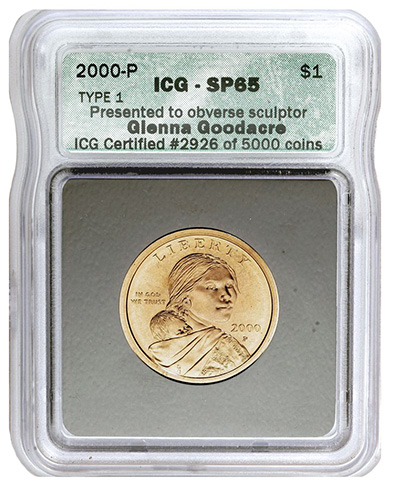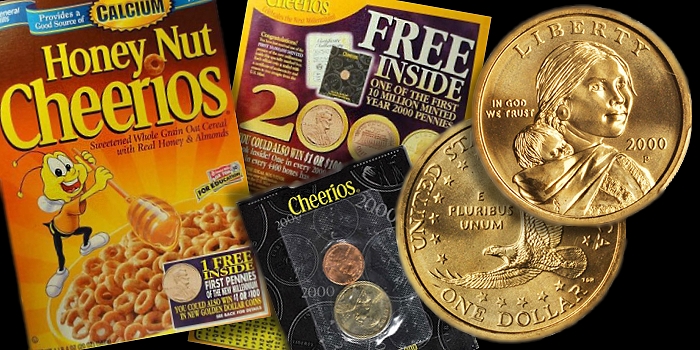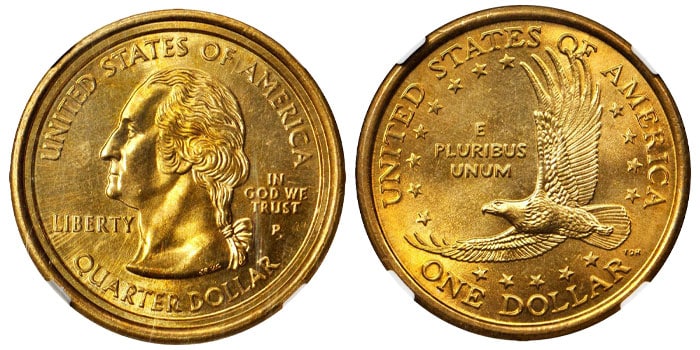By Jeff Garret for NGC
Want to collect this series? Start by looking at the assorted inaugural 2000 issues and deciding what your budget is.
The US Mint recently made an unusual move when it auctioned five examples of the 2000-W Sacagawea Dollar, which had been struck in gold. These previously unavailable numismatic “delicacies” sold for prices between $350,000 and $500,000 each. The history of these coins and the short-lived Sacagawea Dollar series is quite interesting.

The 2025 release of another gold coin to commemorate the 25th anniversary was met with an enthusiastic response, as all 7,500 coins sold out quickly. A collection of Sacagawea Dollars struck from 2000 to 2008 can easily be assembled but would not be complete without spending a considerable fortune.
The Sacagawea Dollar was created in 2000, with a golden color and plain edge to distinguish it from other coins of a similar size. The ill-fated Susan B. Anthony coin was too close in size and color to circulating Quarter Dollars. The new Dollar coinage alloy and change of appearance were mandated by the United States Dollar Coin Act of 1997. The new Sacagawea Dollar coin was struck in pure copper, with a golden outer layer of manganese brass. The obverse design featuring Sacagawea, the Shoshone Indian who assisted the Lewis and Clark expedition, was created by the famed sculptor, Glenna Goodacre. The reverse was designed by Thomas D. Rogers.
The coins produced in 2000 for the introduction of the Sacagawea Dollar are among the most complex and rarity-filled debuts of a coin ever. The following are the different coins issued in just the first year:
2000-P Goodacre Presentation Finish
- Mintage: 5,000
- Graded by NGC: 302
- Finest Graded by NGC: MS 68
Glenna Goodacre had a good working relationship with then-Mint Director Philip Diehl. She had the incredible foresight to request her design fee of $5,000 to be paid in the newly minted coins. At a special ceremony on April 5, 2000, the coins were delivered to her studio by the Mint Director and two Mint Police officers. During early production of the Sacagawea Dollar, the US Mint was having issues with discoloration and many of the coins were produced with a burnished finish, giving the coins a special and distinctive appearance.

These special coins would prove a bonanza for Goodacre. Her studio began selling the presentation coins for about $200 each, and nearly 3,000 were sold before officials at the US Mint protested. Goodacre stopped selling the coins. In 2010, Coin World ran a 10th anniversary article about the Sacagawea Dollar and mentioned the presentation coins and the controversy around her sales. The article also noted that 2,000 coins had remained unsold. Thanks to the power of Google, I was able to contact her agent to inquire about the unsold coins.
After a few months, her agent, Dan Anthony, contacted me to apologize for the delay and shared that they had misplaced the coins. The coins had been found in the wine cellar, and they would indeed be interested in selling them. A quick trip to Sante Fe resulted in me purchasing the 2,000 coins. The coins were sold into the marketplace quickly, with the exception of a few coins retained for my collection. I also developed a great relationship with Goodacre and her agent. I was able to facilitate the transfer of her archival material for early designs to the Smithsonian Numismatic Collection, where they reside today. The collection is a wonderful example of numismatic “what could have been.”
2000-P Cheerios Prototype Sacagawea Dollar
- Mintage: 5,500
- Graded by NGC: 62
- Finest Graded by NGC: MS 69

This famous variety of the Sacagawea Dollar is an early release coin with the tail feathers showing prominent diagonal lines. This was the first type of die in use, and the same one used for the small number of 2000-W gold coins mentioned above. The eagle was later modified to show the tail feathers in parallel lines, this being the regular release. To promote the newly released Sacagawea Dollars, the US Mint arranged with General Mills to create a treasure hunt by placing one of the 5,500 coins struck in every 2,000 boxes of Cheerios.

The unique reverse variety was not recognized until 2005, when a collector sent one to NGC for authentication and grading. By then, most of the issue had been spent and well dispersed. Coins still show up on occasion and still command prices in the thousands of dollars when sold at auction. This issue is one of the most annoying inquiries for coin shops around the country, as the general public has a hard time understanding the subtleties of the variety.
2000-W Gold Sacagawea
- Mintage: 39
- Net Mintage: 12
The US Mint produced 39 Sacagawea Dollar coins in 22-karat gold at the West Point Mint (or possibly Philadelphia) in 1999. All but 12 coins were later melted. These coins were struck with the prototype reverse design, featuring boldly detailed tail feathers. As mentioned above, the prototype reverse design was later used for early circulation strike coins that were packaged as a promotion in boxes of Cheerios cereal.

The one dozen gold examples were sent on the US space shuttle Columbia to honor astronaut Eileen Collins, the first female commander of a space shuttle flight. The coins traveled 1.8 million miles. After years of being stored at Fort Knox, the coins were last publicly displayed at the 2007 World’s Fair of Money in Milwaukee. The US Mint recently sold five examples, creating one of the rarest and most expensive modern coins ever.
2000-P Sacagawea
- Mintage: 767,140,000
- Graded by NGC: 7,089
- Finest Graded by NGC: MS 69
As can be guessed from the high mintage, this issue is very common and can be found with little effort. Interestingly, several hundred million of these and the Denver Mint issue were sent to Ecuador, where they saw extensive circulation.
2000-D Sacagawea
- Mintage: 518,916,000
- Graded by NGC: 1,751
- Finest Graded by NGC: MS 69
IMAGE – A 2000-D Sacagawea Dollar
Another common issue, scarce only in the highest states of preservation.
2000-D Sacagawea Burnished Millenium
- Mintage: 75,000
- Graded by NGC: 439
- Finest Graded by NGC: MS 69
In the US Mint’s 2000 Holiday Catalog, one of the celebratory products offered was the United States Millennium Coin and Currency Set. The set contained a 2000 Silver Eagle, a 2000-D Sacagawea Dollar and a $1 Federal Reserve Note, with the serial number starting with 2000. These sets were offered for $39 each. The Goodacre Dollar was struck with a finish similar to the Goodacre Presentation coins mentioned above.
2000-S Sacagawea Proof
- Mintage: 4,047,904
- Graded by NGC: 17,963
- Finest Graded by NGC: PF 70 Ultra Cameo
(The mintage represented the total coins produced for the Clad and Silver Proof sets of the year.)
Additional Coins
In addition to the above coins produced in 2000 for the Sacagawea Dollar, there were also limited numbers of coins struck during VIP ceremonies at the Philadelphia and Denver Mints. Invited dignitaries and guests could, in some cases, push buttons to have a coin struck. Today, these coins are very rarely encountered and highly desirable.

As if there were not enough regular and special issues of the 2000 Sacagawea Dollar produced, the US Mint also created one of the most desirable mint errors ever. In the 2000s, a small number of coins were struck with a Washington Quarter obverse and the Sacagawea Dollar reverse. Research reveals that the coins were probably intentionally produced.

Two different mint employees were arrested in the case. The US Mint never pursued the return of the coins and they trade freely, yet expensively, in the marketplace. One collector became enamored with the issue and at last count owned the majority of the known examples.
Collecting the first year of issue is a popular pursuit for many numismatists. The 2000 Sacagawea Dollars can create quite the challenge for any collector. The issue is an interesting chapter in the attempt by the US Mint to produce an alternative to the paper dollar. Despite decades of trying, the effort has never been successful. Today, coin collectors are the beneficiaries of the attempt.
Want to see more articles like this? Subscribe to the free NGC Weekly Market Report.
The post The Incredible 2000 Sacagawea Dollars appeared first on CoinWeek: Rare Coin, Currency, and Bullion News for Collectors.
VarietyErrors
Sign up for FREE News, Videos and Articles!

